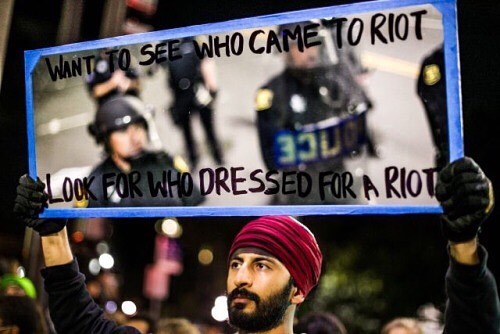Managing Classroom Discussions of Race and Police
A Daily Nous reader sends in a question concerning classroom discussions of recent events and the controversial and sensitive subjects they involve:
Following up on the recent discussion at Daily Nous, I’m writing with a query that I’m wondering if you might be willing to post for comments.
I’m planning to spend a couple of days on race, policing, and police violence in my philosophy of law course this week, and I would love to hear people’s thoughts on leading discussions and managing classroom dynamics when these topics are on the table. I worry about things getting out of hand, but I find myself worrying at least as much about students clamming up (finding the issues too sensitive or the wrongness too obvious). Any thoughts that others have for navigating these discussions would be much appreciated. Thanks so much in advance.
Readers?



In the past I’ve asked students to discuss how many times they’ve been stopped by police, either driving a car or walking about etc., and to describe the experiences and the impact they have on their day-to-day conduct. Usually what happens is that the black men in the class have a *great* deal more to say than the others. The point of this is to shift the students from talking about the issues in the abstract terms they get from the media, and to make it a personal matter — not personal, as in their political views about race reflect on their character, but personal as in their own lived experiences reflect on the politics of race. My sense is that white Americans have very little grasp of just how thoroughly policed their fellow classmates are.
I like to begin with some background stuff on implicit bias. We are all implicated – not just police, and I think it helps when students realize that they are perpetrators of bias themselves as well as victims. There is good research showing problematic racial trends on the part of professors (http://papers.ssrn.com/sol3/papers.cfm?abstract_id=2063742) and problematic gender bias trends on the part of students (http://benschmidt.org/profGender/#), and I start by showing off some of those findings. So of COURSE it’s going to affect police as well, and then I show them that research (http://www.policechiefmagazine.org/magazine/index.cfm?fuseaction=display_arch&article_id=1798&issue_id=5200). By that time in the discussion there is usually a lot of openness to talk further about the effects of bias and violence in policing
There’s an episode of the show “Through The Wormhole” titled “Are We All Bigots?” The answer is yes (of course), but the episode goes on to explain why we are and also what might be done to mitigate that. I’ve found it pretty effective as a way into such conversations. It doesn’t touch on things like structural racism, but my students have been more receptive to those discussions once they realize that bias is nearly impossible to escape.
I think one of the best solutions to the problem of students clamming up is to build an atmosphere of openness and trust in the classroom throughout the semester. I save more sensitive topics for later in the semester when we’ve managed to establish good relationships with one another and good discussion habits. My problem discussing race and policing in my classroom is that I don’t have any training on the politics or philosophy of race, so I feel like I’m not as effective at leading these discussions as I am at leading discussions on disability, violence against women, etc.
EXPLORING RACE IN THE CLASSROOM: SCHOLARS OF COLOR REFLECT, edited by Dr. George Yancy and Dr. Maria del Guadalupe Davidson, Routledge Press, 2014.
I’ve taught these issues for a couple of years now, and been pleasantly surprised at how well students have handled the discussions (I’m in Connecticut, for what it’s worth).
In terms of tips, I’ve found that having relevant data on hand is very helpful for avoiding common misconceptions – for instance, I’ve found students tend to assume that there’s a correlation between areas with high levels of violent crime and police shootings, which is false; or that policing is getting more dangerous, which is also false; or that police exhibit higher levels of implicit bias than other people, which there’s also some evidence is false (at least according to the researchers running the shooter test). I’ve also put together international data for comparison (both rates of police shootings, and shootings of police), which they’ve seemed interested in.
As Implicitor noted, starting with a unit on implicit bias can be really helpful for getting defenses down – though I think there are some risks of then seeing everything through that lens, and thus failing to engage with more structural angles.
I’ve also found it fruitful to couple the discussion of police shootings with discussion of gun control; whenever I’ve taught the topic, students who are concerned about the difficulty of the decisions police have to make also tend to the be students most against gun control, and it’s pretty straightforward to get them to see the tension in that position (even more so now, I imagine, in light of the Castille shooting).
My advice, after 35 years of teaching, is raise the questions and issues in neutral manner, keep your views for later, and let students express themselves. Do, however, stop outrageous, racist stated, or inappropriate comments. By that, I mean do not censor comments but be sure they are stated respectfully. Both sides on such issues can get offensive. Make it clear that inappropriate comments, stated offensively, will not be tolerated. Other than that, I’d let them freely discuss the issues. University and college are supposed to be where free speech and exploring all views takes place. I decry the political correctness and conservative attempts to limit free and open discussion.
“Both sides on such issues can get offensive.”
What is the other “side” when it comes to disproportionate and ridiculous police harassment, abuse, and killing of black and brown people (e.g., Tamir Rice)? Some students might have no idea what trying to frame this issue in a “neutral manner” could reasonably involve.